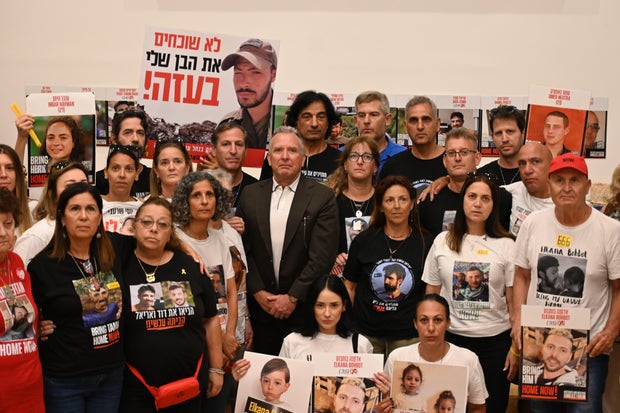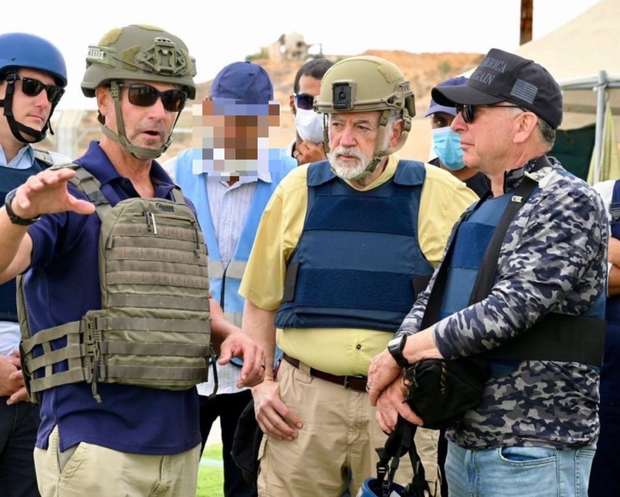U.S. envoy Steve Witkoff on Saturday met with the families of Israeli hostages still held in Gaza in Tel Aviv as fears for the captives’ survival grew nearly 22 months into the war.
The families of the hostages were protesting in Tel Aviv, urging Israel’s government to push harder for the release of their loved ones. Witkoff, who was greeted with some applause and pleas for assistance, joined them for a closed meeting.
Videos shared online showed Witkoff arriving as families chanted “Bring them home!” and “We need your help.”
The Hostages of Missing Families Forum confirmed the meeting, which came a week after Witkoff quit ceasefire talks, blaming Hamas’ intransigence and pledging to find other ways to free the hostages and make Gaza safe.
Hostages of Missing Families Forum
After the meeting, the Forum released a statement saying that Witkoff had given them a personal commitment that he and President Trump would work to return the remaining hostages.
“We will get your children home and hold Hamas responsible for any bad acts on their part. We will do what’s right for the Gazan people,” Witkoff said in the meeting, according to the Forum.
Of the 251 hostages who were abducted by Hamas-led terrorists on Oct. 7, 2023, around 20 are believed to be alive in Gaza. Hamas and Islamic Jihad, the second-largest militant group in Gaza, released separate videos of individual hostages this week, triggering outrage among hostage families and Israeli society.
Israeli media haven’t broadcast the videos, calling them propaganda, but the family of 21-year-old Rom Braslavski allowed the release of a photograph showing him visibly emaciated in an unknown location. After viewing the video, Tami Braslavski, his mother, blamed top Israeli officials and demanded they meet with her.
“They broke my child, I want him home now,” Braslavski told Ynet on Thursday. “Look at him: Thin, limp, crying. All his bones are out.”
Protestors called on Israel’s government to make a deal to end the war, imploring them to “stop this nightmare and bring them out of the tunnels.”
“Do the right thing and just do it now,” said Lior Chorev, chief strategy officer of the Hostages and Missing Families Forum.
Witkoff’s meeting with the families came a day after he and U.S. Ambassador to Israel Mike Huckabee toured one of the privately run U.S. and Israeli-backed Gaza Humanitarian Foundation’s distribution sites in the southern Gaza city of Rafah.
Steve Witkoff
“We received briefings from (the IDF) and spoke to folks on the ground. GHF delivers more than one million meals a day, an incredible feat!” Huckabee said in a social media post.
The GHF’s four distribution sites, which are in zones controlled by the Israeli military, have become flashpoints of desperation, with mass crowds of people gathering outside but who have then come under fire from Israeli forces or been trampled in the resulting crush.
On Saturday, hospitals in Gaza reported the killing of more than a dozen people, eight of them food-seekers, by Israeli fire.
Near a GHF distribution site, Yahia Youssef, who had come to seek aid Saturday morning, described a panicked scene now grimly familiar. After helping carry out three people wounded by gunshots, he told the Associated Press he looked around and saw others lying on the ground bleeding.
“It’s the same daily episode,” Youssef said.
In response to questions about several eyewitness accounts of violence at the northernmost of the Israeli-backed American contractor’s four facilities, GHF said “nothing (happened) at or near our sites.”
“We weren’t close to them (the troops) and there was no threat,” Abed Salah, a man in his 30s who was among the crowds close to the GHF site near Netzarim corridor, said. “I escaped death miraculously.”
From May 27 to July 31, 859 people were killed near GHF sites, according to a United Nations report published Thursday. Hundreds more have been killed along the routes of food convoys.
GHF says its armed contractors have only used pepper spray or fired warning shots to prevent deadly crowding. Israel’s military has said it has only fired warning shots at people who approach its forces, though on Friday said it was working to make the routes under its control safer. Israel and GHF have said that the toll has been exaggerated.
Israel’s military did not immediately respond to questions about the deaths near the aid sites. Its top general, meanwhile, warned Saturday that “combat will continue without rest” if hostages weren’t freed. Lt. Gen. Eyal Zamir said Israel’s military would adapt to “place Hamas under increasing pressure.”
The war in Gaza began when Hamas attacked southern Israel on Oct. 7, 2023, killing around 1,200 people, mostly civilians. Israel’s retaliatory offensive has killed more than 60,000 Palestinians, according to Gaza’s Hamas-run Health Ministry, which doesn’t distinguish between militants and civilians and operates under the Hamas government. The U.N. and other international organizations see it as the most reliable source of data on casualties.
contributed to this report.


